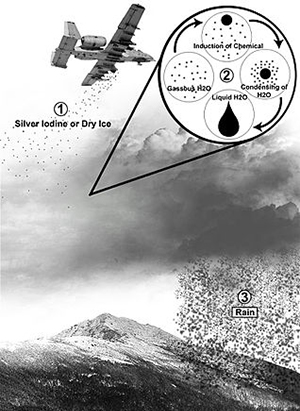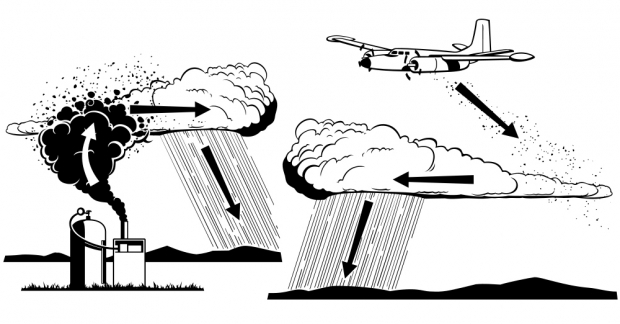Will it be clear or gray skies today? Increasingly, the answer in China may be decided by the government.
The Chinese have been seeding clouds for decades. Airplanes equipped with rocket-launchers and chemicals for inducing rainfall are based in thousands of counties across the country.
In May, though, the head of the China Meteorological Administration (CMA), Zheng Guoguang, spelled out dramatic details for a previously announced plan to ramp up weather modification. The goal is to increase precipitation by 3 to 5 percent nationwide over the next five years through cloud-seeding.

Guo Xueliang, director of CMA’s artificial weather intervention center, said typically about 30 trillion tons of water vapor floats across China’s skies every year, and about 6 trillion tons falls as rain. And he’s sure more can be squeezed from the clouds.
“At least another 1 percent of cloud water could be transformed to fall as rain every year,” he said, “or roughly 280 billion tons.”
Thundering Success
China started its cloud-seeding program in 1958 based on the findings of a Swedish rain researcher and scientist named Tor Bergeron. That summer, the nation’s first artificial rain showered Jilin province following government cloud-seeding.
To date, some 2,235 of the nation’s 2,900 counties have organized programs for seeding clouds to get rain, unleashing hundreds of billions of tons of water on farms and cities alike.
About thirty countries around the world have put cloud-seeding programs in place. But none are as big as China’s, and many programs have been limited by high costs and fears of environmental risk.
Environmentalists in China have argued against cloud-seeding, too. Some argue that inducing rain in southeast coastal areas robs rainfall from western parts of the country where it’s badly needed, turning dry regions even more arid.
CMA stepped up artificial weather intervention expenditures in 2007, stirring debates about the use of public funds for what some called a poorly coordinated effort. The Ministry of Finance allocated 160 million yuan this year to subsidize local government weather modification projects, according to the official Xinhua News Agency.
The size of China’s program eclipses the rest around the world because, officials say, inducing artificial rainfall is a proper response to water shortages brought on by the country’s unique climate conditions.
“China ranks first in terms of precipitation projects because our country has a desperate water shortage,” said Wang Guanghe, deputy director of CMA’s artificial weather center. “Other countries such as the United States and France have more water resources. So, accordingly, the scale of their artificial rainfall projects is not as large as ours.”
China has also pursued expensive research into cloud-seeding, even though much of the work has been fruitless, said a source who has worked with the nation’s meteorology programs since the 1980s.
Countries around the world are continuing to conduct research into cloud-seeding technology, but none have matched the scale of China’s programs, said Lu Chen, a senior engineer at the Beijing Meteorological Bureau.
However, theoretically, said Chen Guangting, a climate researcher at the Chinese Academy of Sciences, any rain that falls in one place reduces the amount available elsewhere.
“In theory, the total amount of water in cloud resources is constant,” Chen said. “If one place conducts a precipitation project, cloud-seeding projects in other places will be affected.”
Zheng, however, argued at a conference in June that although artificial rainfall projects probably affect total rain distribution, “the effect is insignificant.”
In hopes of getting more bang for their bucks, some provinces earlier this year proposed forming regional projects modeled after a unique, multi-province approach to cloud-seeding in northeast China. Guo said provincial coordination may yield more rainfall than would be possible through piecemeal, localized seeding.
Yet cloud-seeding skeptics question the value of any size project, arguing that the process remains unreliable—even unscientific.
“The present technology is incapable of ensuring how much artificial rainfall will be produced,” said a meteorologist who refused to be named. “In addition, it could be a huge waste of resources if rainfall can’t be consistently maintained.”
Nor have official government statements prevented some scientists from questioning post-seeding reports of success and significant rainfall.
Mao Jietai, a professor at Peking University’s Department of Atmospheric Science, is among those who has questioned the reliability of seeding procedures when compared to natural rainfall. Nor does he support man’s exploiting of nature.
“Human beings need to acknowledge their reliance on nature,” Mao said.
The Beijing weather bureau’s Lu agreed. “The use of cloud-seeding technology on a large scale remains open to question,” he said.
Liu Hongqiao is a Caixin staff reporter.




